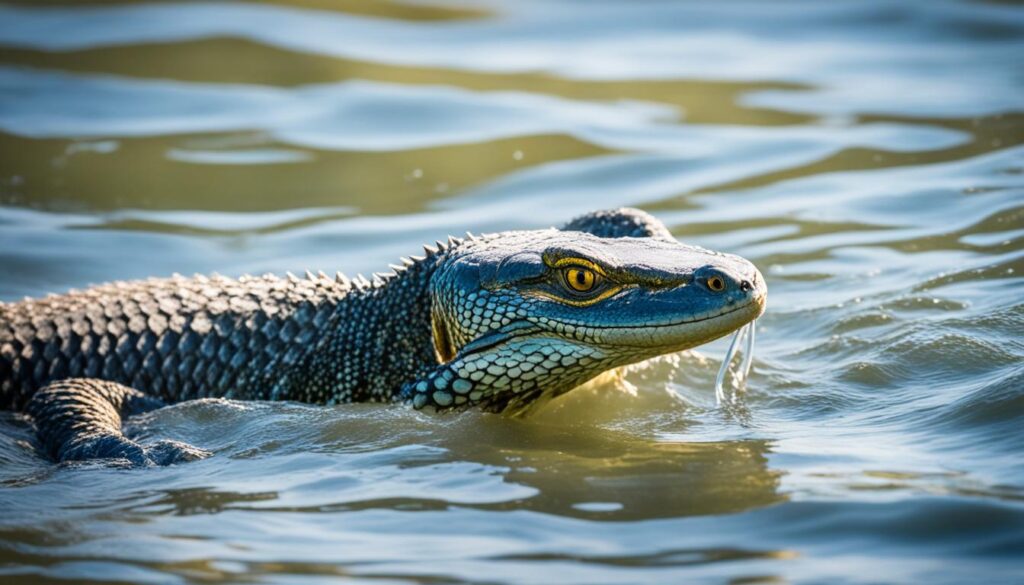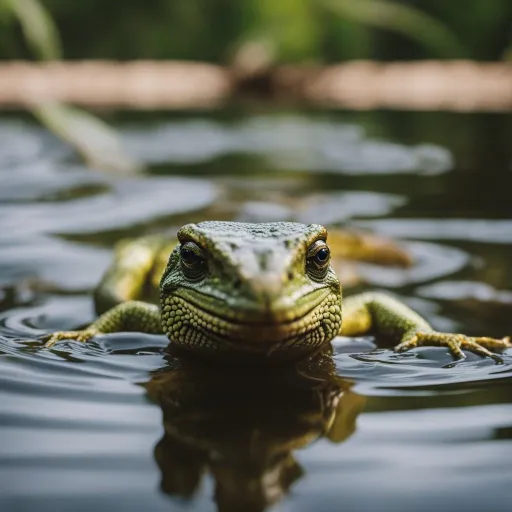Did you know that monitor lizards, a diverse group of reptiles known for their impressive size and strength, have a surprising affinity for swimming?
Yes, these fascinating creatures, which can reach lengths of up to 10 feet and weigh over 150 pounds, are not only skilled terrestrial hunters but also skilled swimmers!
In this article, we will take an in-depth look at the swimming behavior of monitor lizards, their physical adaptations for aquatic habitats, and the benefits they derive from their love of water.
From their sleek bodies to their powerful limbs, monitor lizards are well-equipped to navigate through water with grace and ease.
Join us as we dive into the world of monitor lizards and unravel the mysteries of their unique relationship with swimming.
Key Takeaways:
- Monitor lizards, known for their size and strength, also display remarkable swimming abilities.
- They possess physical adaptations that make them well-suited for aquatic environments.
- Swimming provides numerous benefits for monitor lizards, including hunting, escaping predators, and regulating body temperature.
- Observations and studies have shed light on their swimming behavior and interactions with water.
- Caring for pet monitor lizards involves providing appropriate water environments and considering the health benefits of swimming.
Understanding Monitor Lizards
When it comes to the fascinating world of monitor lizards, gaining a deeper understanding of these incredible creatures is key.
Let’s explore the different species within the Varanus genus and delve into their impressive physical adaptations that make them well-suited for their swimming prowess.
Overview of Monitor Lizard Species
The Varanus genus encompasses a wide range of monitor lizard species, each with its own unique characteristics.
From the iconic Komodo dragon to the agile water monitors, these reptiles captivate us with their diversity.
Understanding the distinct traits and behaviors of each species adds to our appreciation of the monitor lizard family.
Physical Adaptations for Swimming
Monitor lizards possess remarkable physical adaptations that enable them to navigate through water with ease.
Their strong limbs and muscular tails act as powerful propellers, propelling them effortlessly through the aquatic environment.
Sharp claws provide excellent grip while swimming, allowing these reptiles to maneuver and explore their surroundings effectively.
Monitor Lizards and Their Aquatic Habits
Monitor lizards, also known as varanids, have a fascinating affinity for water. They are well-known for their aquatic habits, which play a significant role in their lifestyle.
Let’s explore the species of monitor lizards that are particularly adept at swimming and the importance of water in their natural environment.
Species Known for Swimming
Among the various species of monitor lizards, some have gained recognition for their exceptional swimming abilities.
The Water Monitor (Varanus salvator) is one such species known for its aquatic prowess.
Found in Southeast Asia, this monitor lizard has a sleek body and muscular tail, allowing it to gracefully navigate through water.
The Nile Monitor (Varanus niloticus), native to Africa, is another species that exhibits strong swimming skills.
These species showcase the remarkable adaptability of monitor lizards in diverse aquatic environments.
The Role of Water in Their Lifestyle
Water plays a crucial role in the lifestyle of monitor lizards. It serves as more than just a source of hydration.
For these reptiles, water provides opportunities for foraging and hunting. Monitor lizards are skilled hunters both on land and in water, using their powerful jaws to catch fish, crustaceans, and other aquatic prey.
Water also offers them a sanctuary, allowing them to escape predators and seek refuge.
Moreover, monitor lizards utilize water bodies for thermoregulation, regulating their body temperature by immersing themselves in water or basking on the banks.
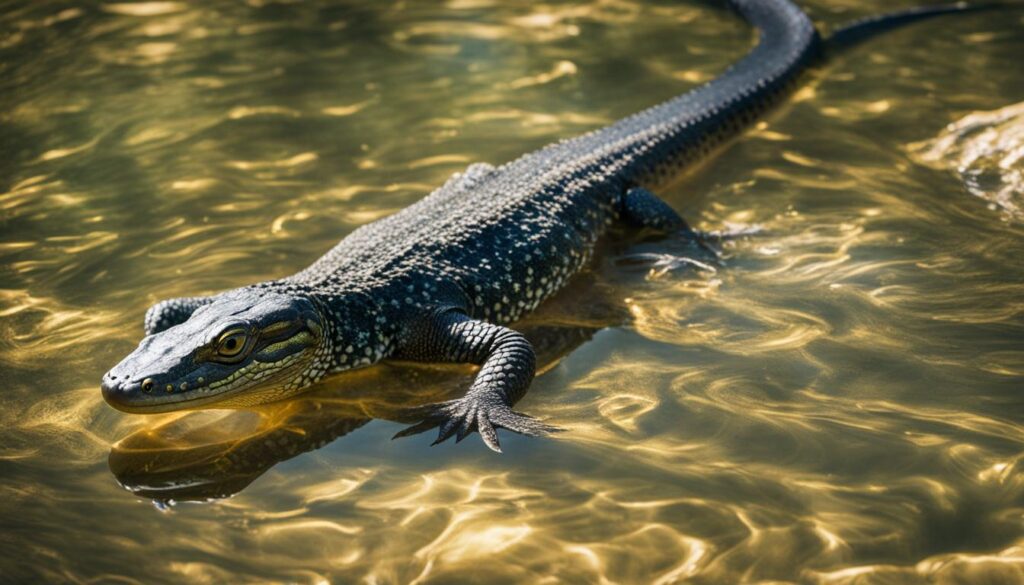
Monitor lizards’ ability to thrive in aquatic environments is truly remarkable. These reptiles have adapted to incorporate water into their lifestyle in various ways, making them a unique and intriguing species to study.
The Swimming Behavior of Monitor Lizards
In this section, we will explore the fascinating swimming behavior of monitor lizards.
These reptiles possess unique swim techniques, utilizing their powerful leg muscles and tails to navigate through water with ease.
How Monitor Lizards Swim
Monitor lizards employ a combination of powerful strokes and rhythmic movement to propel themselves through the water.
Their well-developed leg muscles allow them to paddle efficiently, while their long, muscular tails serve as effective rudders, aiding in steering and stability.
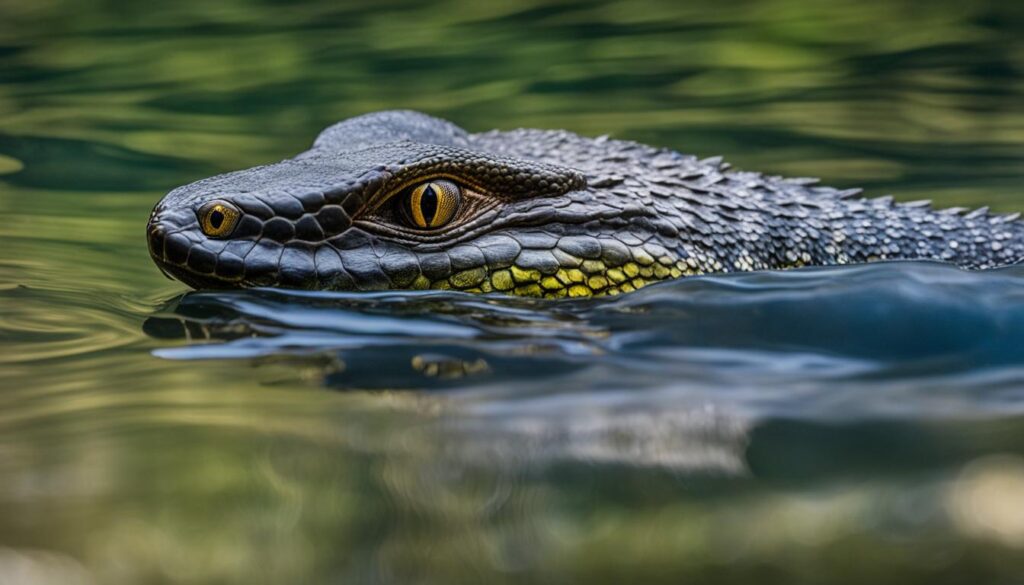
Frequency and Duration of Swimming
The frequency and duration of monitor lizards’ swimming activities vary depending on several factors, including their species, habitat, and environmental conditions.
Some species are more aquatic than others and may spend a significant amount of time in water, swimming regularly to hunt or explore their surroundings.
Monitor lizards typically engage in short to moderate swimming sessions, ranging from a few minutes to several hours, depending on their needs.
These reptiles have the ability to adapt their swimming behavior to suit their specific requirements, whether it’s traversing across water bodies or searching for food.
Understanding the swimming behavior, swim techniques, frequency, and duration of monitor lizards is crucial for gaining insight into their natural habitats and overall well-being.
Benefits of Swimming for Monitor Lizards
Swimming offers a range of benefits for monitor lizards, making it an essential aspect of their lifestyle.
Let’s take a closer look at how swimming aids in their hunting and foraging activities, as well as their ability to escape from predators and regulate their body temperature by cooling off in water.
Hunting and Foraging
Swimming plays a crucial role in the hunting and foraging behaviors of monitor lizards.
These agile reptiles are known to stalk their prey near bodies of water, utilizing their swimming prowess to swiftly chase down potential meals.
Their ability to swim allows them to explore a wider range of habitats, increasing their access to a diverse variety of prey.
By venturing into the water, monitor lizards can hunt for fish, tadpoles, crustaceans, and other aquatic creatures, expanding their dietary options and ensuring their nutritional needs are met.
Furthermore, swimming enables monitor lizards to access inaccessible areas, such as small islands or hard-to-reach spots along the shoreline.
This provides them with an advantage in their search for prey, as they can explore and exploit different habitats to maximize their hunting success.
Escaping Predators and Cooling Off
In addition to hunting and foraging benefits, swimming also serves as a vital tool for monitor lizards when it comes to escaping predators and regulating their body temperature.
Being excellent swimmers allows them to quickly flee from land-dwelling predators that may pose a threat, such as large mammals or other reptiles.
Moreover, water acts as a natural coolant for monitor lizards, helping them regulate their body temperature in hot environments.
By submerging themselves in water, they can dissipate excess heat and avoid overheating.
This behavior is particularly crucial for monitor lizards, as they are ectothermic animals that rely on their environment to maintain their body temperature.
Swimming allows them to cool off and maintain optimal physiological functioning.
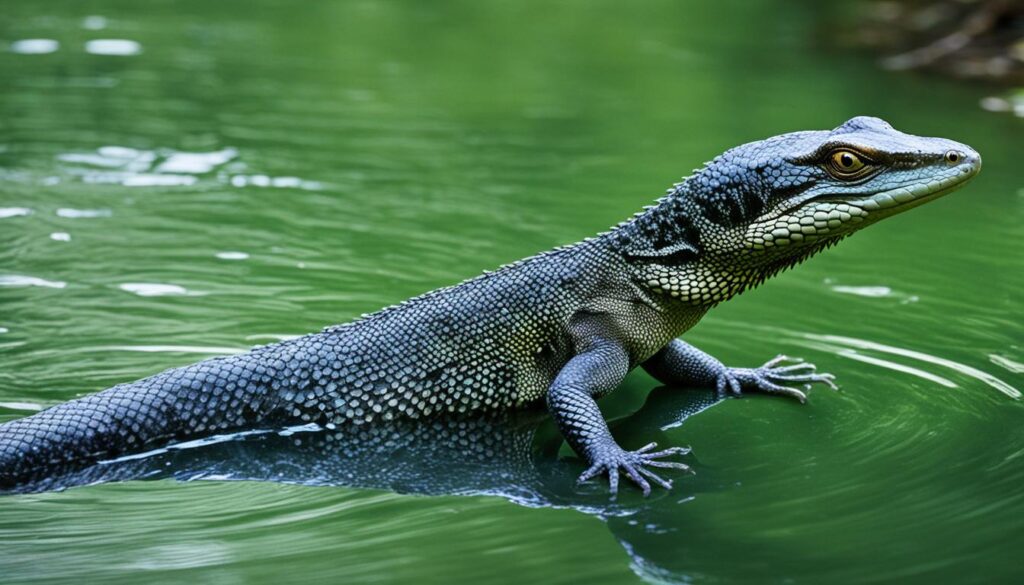
In conclusion, swimming offers a range of benefits for monitor lizards. It enhances their hunting and foraging capabilities by expanding their access to different prey and habitats.
Additionally, swimming enables them to escape from land-based predators and regulate their body temperature by cooling off in water.
As we continue to explore the world of monitor lizards, it becomes increasingly apparent that swimming is an essential and integral part of their lifestyle.
Observations of Monitor Lizards in Water
When it comes to monitor lizards, their behavior in water has intrigued researchers and enthusiasts alike.
Through extensive behavioral studies and observations, we have gained valuable insights into their swimming habits and interactions with water.
Behavioral Studies and Observations
Scientists have conducted numerous studies in the wild to better understand the swimming behavior of monitor lizards.
These studies involve observing their movements, diving capabilities, and hunting techniques in aquatic environments.
By closely monitoring monitor lizards in their natural habitats, researchers have been able to uncover fascinating insights into their adaptation to water and their swimming prowess.
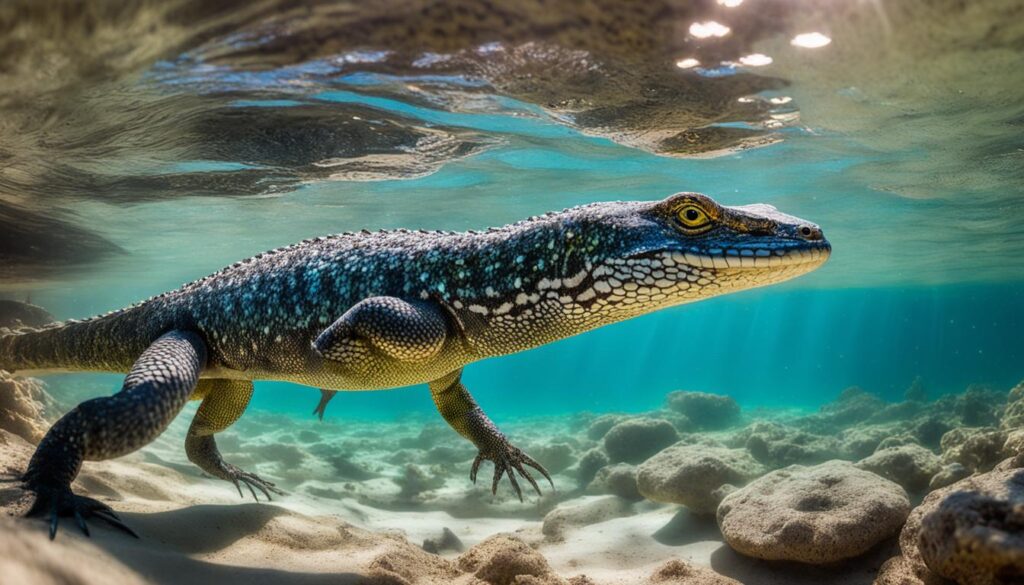
Interaction with Human-Made Water Bodies
In addition to their behavior in natural water sources, monitor lizards have also been observed interacting with human-made water bodies.
These man-made environments, such as ponds, lakes, and swimming pools, often attract monitor lizards seeking water and prey.
These observations provide valuable information about the adaptability and resourcefulness of monitor lizards in urban settings.
Through ongoing research and continued observation, we can continue to expand our knowledge of monitor lizards’ behavior in water.
These studies offer a deeper understanding of their natural instincts and provide important insights into their conservation and care.
Caring for Monitor Lizards: Water and Swimming
When it comes to caring for monitor lizards, providing them with the right water environments is essential.
Water plays a crucial role in their well-being, as it allows them to engage in their natural swimming behaviors and offers a range of health benefits.
Here’s what you need to know to ensure your pet monitor lizard stays happy and healthy.
Providing Water Environments for Pet Monitor Lizards
Creating a suitable water environment for your pet monitor lizard involves several key considerations.
First and foremost, you’ll need to provide a spacious and secure water source. This can be a large shallow pool or a deep container, depending on the size and species of your lizard.
The water source should be large enough for your pet to swim and dive comfortably.
It’s important to maintain the cleanliness of the water to prevent any potential health issues.
Regularly clean the water source and change it as needed to ensure it remains fresh and free from debris.
Additionally, monitor lizards prefer warm water temperatures, so monitor and adjust the water temperature regularly to provide them with the optimal conditions.
Your pet monitor lizard’s water source should also include appropriate hiding spots and basking areas.
This allows them to regulate their body temperature and feel secure while swimming. Adding rocks, logs, or plants to the water environment will provide your lizard with the necessary elements to simulate their natural habitat.
Health Benefits and Considerations
Swimming is not only a natural behavior for monitor lizards but also offers various health benefits.
Regular swimming exercises their muscles, improves cardiovascular fitness, and contributes to their overall physical strength.
It can also aid in shedding their skin and maintaining proper hygiene.
However, while swimming is beneficial, it’s crucial to monitor your pet’s swimming sessions and not leave them unattended.
Some monitor lizard species are excellent swimmers, while others may struggle and get tired easily.
Be mindful of their swimming capabilities and gradually introduce them to the water environment.
Always ensure they have easy access to dry land and do not force them to swim if they show signs of distress or fatigue.
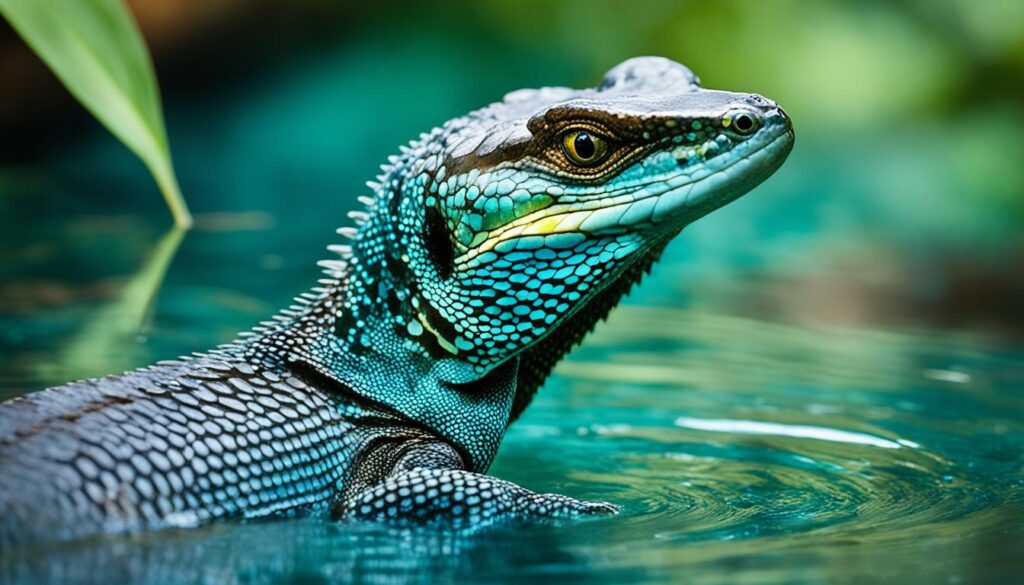
In conclusion, caring for monitor lizards includes providing suitable water environments for their swimming activities.
By creating the right conditions and monitoring their swimming sessions, you can promote their physical well-being while offering them an enriched and fulfilling life.
Conclusion
Throughout this article, we’ve delved into the fascinating world of monitor lizards and their affinity for swimming.
We’ve learned that monitor lizards, with their physical adaptations and powerful swimming techniques, are well-suited for aquatic habitats.
Their ability to swim benefits them in various ways, from hunting and foraging to escaping predators and regulating their body temperature.
Observations and behavioral studies have provided valuable insights into monitor lizards’ interactions with water, both in the wild and in human-made water bodies.
These studies help us better understand their swimming behavior and the role water plays in their lifestyle.
For those who keep monitor lizards as pets, providing appropriate water environments is essential.
A clean and properly-sized water source, along with regular swimming opportunities, is crucial for their well-being.
Swimming not only promotes their physical health and fitness but also adds to their natural behavior and overall enrichment.
In conclusion, monitor lizards’ affinity for swimming is a fascinating aspect of their biology.
Understanding their swimming behavior and providing them with suitable water environments allow us to appreciate and care for these incredible creatures.
So, whether you encounter monitor lizards in the wild or keep them as pets, remember to celebrate their unique relationship with water and the benefits that swimming brings to their lives.
Frequently Asked Questions
Q: Can all monitor lizards swim?
A: Yes, all monitor lizards have the ability to swim. They are adaptable reptiles with bodies well-suited for swimming, allowing them to navigate through water efficiently.
Q: Can monitor lizards swim in the ocean?
A: Some species of monitor lizards can swim in the ocean, particularly those living in coastal areas. They are capable of handling the saline environment for short periods, though they primarily inhabit freshwater and terrestrial habitats.
Q: Can monitor lizards swim in a swimming pool?
A: Monitor lizards can swim in swimming pools, but it’s not their natural habitat. They are capable swimmers and can navigate in pool water without difficulty. However, chlorine and other pool chemicals may not be safe for them.
Q: Can monitor lizards swim in Florida?
A: Monitor lizards, such as the invasive Nile monitors found in Florida, can indeed swim. Florida’s waterways, swamps, and lakes provide suitable environments for these lizards to navigate and hunt.
Q: Can monitor lizards swim underwater?
A: Yes, monitor lizards can swim underwater. They are skilled swimmers and can dive to hunt for food or escape predators. Their ability to swim underwater is one of their many adaptative traits.
Q: How long can a monitor lizard stay underwater?
A: Monitor lizards can stay underwater for up to 30 minutes. This ability varies among species and depends on their size, age, and health. Staying underwater helps them hunt and avoid predators.
Q: How long can a monitor lizard stay underwater in Florida?
A: The invasive Nile monitor lizards in Florida can stay underwater for about 15 to 30 minutes, similar to other monitor lizard species. This skill is useful for hunting and evading capture in Florida’s aquatic environments.


